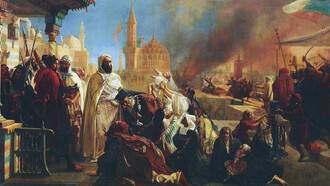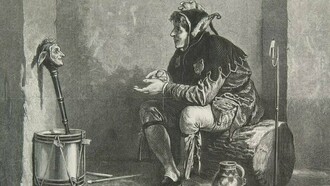Art has long been a medium for expression, storytelling, and communication. While early humans started with figurative cave paintings depicting animals and hunting scenes, they gradually shifted toward abstract symbols and rock carvings. This transition marks the beginning of a new phase in human creativity—one that would eventually lead to the birth of writing. In this chapter of Journey of Art, we explore how early rock art evolved into symbols, laying the foundation for the first written languages.
The shift from representation to abstraction
The earliest cave paintings, such as those found in Lascaux, France, and Altamira, Spain, were primarily representational, showcasing detailed depictions of animals, hand stencils, and hunting scenes. However, as time progressed, early humans began incorporating abstract shapes, geometric patterns, and repetitive symbols into their artwork. These shapes, such as spirals, dots, and zigzags, appear across multiple ancient sites, suggesting they held a deeper meaning beyond mere decoration.
One of the most striking aspects of this shift is that similar symbols have been discovered in vastly different regions, from Europe to Africa, Australia, and the Americas. This universal emergence of abstract symbols suggests a growing human need for communication beyond simple imagery.
Petroglyphs and pictograms: the first visual language
Petroglyphs, or rock carvings, represent one of the earliest forms of symbolic communication. Unlike cave paintings, which were created using pigments, petroglyphs were chiseled or scratched into rock surfaces using stone tools. These carvings often depicted animals, human figures, and abstract symbols, indicating early attempts at storytelling and record-keeping.
In some regions, petroglyphs evolved into pictograms—simple images that conveyed specific meanings. For example, in Mesopotamia, early pictograms on clay tablets would later develop into cuneiform writing. Similarly, the hieroglyphs of ancient Egypt originated from pictorial symbols. This gradual transition from imagery to structured writing systems shows how visual art played a crucial role in shaping human communication.
Common symbols in early rock art
Certain symbols appear repeatedly in rock art across different cultures and continents. Some of the most common motifs include:
Spirals and circles: found in sites such as Newgrange in Ireland and the petroglyphs of the American Southwest, spirals are often linked to cycles of life, the sun, and spiritual beliefs.
Handprints: these appear worldwide, from Argentina’s Cueva de las Manos to the Indonesian caves of Sulawesi. They may have represented personal identity, spiritual presence, or even early forms of signatures.
Dots and lines: often arranged in specific sequences, these could have been rudimentary counting systems, mapping tools, or abstract representations of ideas.
Animal tracks: many sites feature carved or painted tracks, which may have served as hunting guides or symbolic representations of animal spirits.
These recurring symbols suggest that early humans were beginning to assign meaning to abstract forms, a crucial step toward written language.
The role of symbols in rituals and trade
Rock art was not just a form of self-expression but also played a significant role in rituals and social organization. Some petroglyph sites are believed to have been sacred spaces, used for ceremonies, storytelling, or marking important events. Shamans and spiritual leaders may have used these symbols in their practices, reinforcing the connection between early art and spiritual evolution.
Additionally, symbols may have served practical functions, particularly in trade and migration. Some archaeologists suggest that rock markings acted as territorial markers or directional guides for nomadic groups. Early traders could have used specific symbols to communicate with distant groups, facilitating the exchange of goods, ideas, and cultural practices.
Regional examples of early rock art and symbols
Europe: the Upper Paleolithic caves of France and Spain contain some of the earliest known abstract symbols alongside figurative paintings. The presence of repeated dot patterns and geometric engravings hints at symbolic communication.
Africa: the petroglyphs of the Sahara Desert, such as those in Tassili n’Ajjer, depict not only animals and human figures but also abstract forms that may have served as early symbols of identity or cultural significance.
Australia: aboriginal rock art features intricate dot patterns, hand stencils, and symbolic depictions of the Dreamtime—an essential part of indigenous cosmology and storytelling.
The Americas: in the southwestern United States, petroglyphs created by Ancestral Puebloans include spirals, animal figures, and celestial symbols, potentially linked to astronomical observations.
From rock art to writing: the next evolutionary step
The gradual transition from pictorial symbols to formalized writing systems occurred over thousands of years. While early petroglyphs and pictograms conveyed meaning through imagery, the need for more complex communication led to the development of structured scripts.
Sumerian Cuneiform: originating around 3100 BCE, cuneiform evolved from pictograms into wedge-shaped marks pressed into clay tablets, becoming one of the first true writing systems.
Egyptian Hieroglyphs: emerging around the same period, hieroglyphic writing maintained its pictorial nature but developed into a sophisticated script used for religious texts, official inscriptions, and daily record-keeping.
Chinese oracle bone script: around 1200 BCE, early Chinese writing appeared on turtle shells and animal bones, combining pictorial elements with phonetic components.
This evolution underscores how art, in its earliest forms, laid the groundwork for one of humanity’s most significant achievements: the ability to record and transmit knowledge across generations.
Conclusion: art as the foundation of human communication
The transition from rock art to written symbols marks a pivotal moment in human history. What began as simple carvings on cave walls eventually led to the creation of sophisticated writing systems that would shape civilizations for millennia.
Rock art was more than just decoration—it was a tool for communication, a means of preserving knowledge, and a bridge between the physical and spiritual worlds. By examining these ancient symbols, we gain insight into the minds of our ancestors and their desire to make sense of the world around them.
As we continue the Journey of Art, we will explore how monumental structures, such as Göbekli Tepe and Stonehenge, further reflect the evolving artistic and social capabilities of early human societies. These structures, like rock art, serve as testaments to humanity’s enduring need to create, communicate, and leave a lasting mark on the world.















